

Refusal and Autonomy within Colonially Mediated Molecular Relations is a text co-authored with Dr. Krystal Tsosie for the collective monograph, Synthetic Becoming "This contribution begins with the script, screenshots, and visuals from Rian Ciela Hammond’s recent short film Root Picker—a queer nature documentary centered around wild yams who were historically the main feedstock gloally for the production of steroid hormone pharmaceuticals. Through this ecological, historical excavation, hormones are understood as colonial artifacts—microbeings colonized by binary gender ideology and some of the first 'natural substances' to be patented, opening the door for the patenting of genes, cells, microbes, and plants. The script of Root Picker is followed by Hammond’s conversation with Dr. Krystal Tsosie. Together they discuss what bio-colonialism is and does historically and presently in the ongoingness of settler colonialism, what an anti-colonial science looks like, how biomolecules can be decolonized, and why “open source science” can serve as a tool of oppression, deepening pre-existing global intra-communal disparities and aiding extractive practices like bio-commercialism or bio-colonialism.""
On view in DIFFERENCE MACHINES (Oct 16th 2021 - January 16th 2022 at the Albright-Knox Art Gallery of Buffalo NY) and Future Ecologies (Fall 2021 at Vox Populi of Philadelphia PA) Root Picker is a queer nature documentary focused on a family of wild yams found throughout the Americas. Footage of yams thriving in swampy wetland ecologies is viewed through screen interfaces mapping the steroid hormonal molecular transformations that occur between yam, fungal, and human bodies. On view for DIFFERENCE MACHINES at Albright-Knox gallery of Buffalo NY, the video installation accompanies a bioreactor that incubates fungal microbes fermenting phytosteroids extracted from wild yams, and transforming them into progesterone and other steroid hormones.
Issue 13 of Culture Push's digital publication PUSH/PULL, edited by artist and organizer Eli Brown, brought together people "who are doing intergenerational work in the community, are making work around trans-ness and time, or hold critiques around the systems in place meant to serve LGBTQ+ folks who are aging." My contribution included an excerpt of the text MAPPING A HORMONE HYPEROBJECT illustrated with a series of digital collages and video works from the virtual exhibition Molecular Female.
Molecular Female is a virtual exhibition that explores the history of the search for plants used in the development and production of synthetic hormones. Released initially by El Museo of Buffalo NY where the show also had a physical presence through the month of October.
Mapping a Hormone Hyperobject featured in a book by the Bioart Society, publishd by Aalto ARTS Books. "Art as We Don’t Know It showcases art and research that has grown and flourished within the wider network of both the Bioart Society and Biofilia during the previous decade. The book features a foreword by curator and art historian Mónica Bello, and a selection of peer-reviewed articles, personal accounts and interviews, artistic contributions and collaborative projects which illustrate the breadth and diversity of bioart. The resulting book is a tantalising and invaluable indicator of trends, visions and impulses in the field."
Originally conceived as multiple iterations in different locations, TRANS FUTURES was unfortunately interrupted by the Covid-19 pandemic. The first TRANS FUTURES workshop / transgenic performance was run in collaboration with MedialabMX in Mexico City during February of 2020.Over the course of 3 days spread out through a week we performed plant transgenesis with the soil bacteria Agrobacterium Tumefaciens who is able to insert “xenogenes” into a plant’s genome. Looking at the coloniality embedded in current manifestations of these technologies, we asked: what alter past~present~futures can we create, and how can we, "repurpose technologies for progressive gender political ends..." as challenged by Xenofeminism.
O FLUXO | TZVETNIK Work presented as part of a exhibit the multi-format publication, "Common Survival" curated by the Institute of Queer Ecology (IQECO). The publication was exhibited from May 26 - July 1 2018 at Prarie Chicago, and from January 26–April 14 2019 at Gas Gallery in Los Angeles.
text for conjuring a hormonal hyperobject Press Release PDF | ISCP Event Page | FCINY The Beyond Binaries symposium approaches the challenge of deconstructing two central binaries of Western culture: binary gender and the human-animal divide. How are the cultural constructs of gender and humanity/animality manifested and reified in science and law? How are these constructs intertwined with struggles to dismantle current day racism and cisheterosexism—bias that reinforces gender-normativity—and how can we form new ways of understanding? These questions are addressed from the vantage points of visual art, theory, and activism, by four speakers."
Workshop taught at Der Raumstation in collaboration with Mary Maggic to extract endocrine disruptors and xenoestrogens from personal care products, and experiment with the fungus Schizophyllum Commune's ability to bio-degrade these chemicals. "Schizophyllum commune is an extraordinary mushroom with over 28,000 sexes, anti cancer properties, and the ability to break down toxicities. The workshop will begin with presentation on Rian and Mary's Prototyp_ome residency at Hangar.org Barcelona in collaboration with Paula Pin and this multifaceted mushroom."
At dutch design week we presented a diy "directed evolution" experiment that exposed petrochemical degrading fungi to high levels of xenoestrogens extracted from beauty products, herbicides, plastics, and personal care products. Xenoestrogen Microdoser : fed endocrine disrupting petrochemicals to S.commune (the fungi) in increasing concentrations overtime, inducing mutagenesis for thriving in a sea of endocrine disrupting toxicants. Becoming together.In collaboration with Paula Pin and Mary Maggic
From August-October 2017 HANGAR provided funding and support for OSG research and development as well as development of new work in collaboration with Paula Pin and Mary Maggic. While in residence I developed a series of 8 plasmids (circular DNA) to be used in the metabolic engineering of yeast and plants to produce human growth hormones. Mary and I also explored ways of being with and learning from the mushroom Schizophyllum Commune and it's various entanglements with endocrine disrupting petrochemicals. HANGAR: OSG Project Description HANGAR: Mary and Ryan Collaborative Research Description
"The development of these production technologies from the late 1800’s up to the present is entangled with power structures and ideological frameworks that co-create bodies, subjectivities, and genders. Efforts to eliminate queer, gender non-conforming, non-reproductive behaviors - as well as increase heterosexual prowess and enable lifelong performance of sanctioned masculinities and femininities drove the development of these technologies. Geopolitical forces, state enforced frameworks for the ownership of organisms and biomolecules, colonially imposed and medically enforced binary frameworks of sex and gender, population control and reproductive regimes have sculpted and co-created what we commonly refer to as “male and female sex hormones.” This is what’s most interesting to me, to collage and patch together an image of molecular technologies of gender as hyperobjects that I’m inescapably tangled in, and then involving myself in the parts that are least visible or accessible to me."
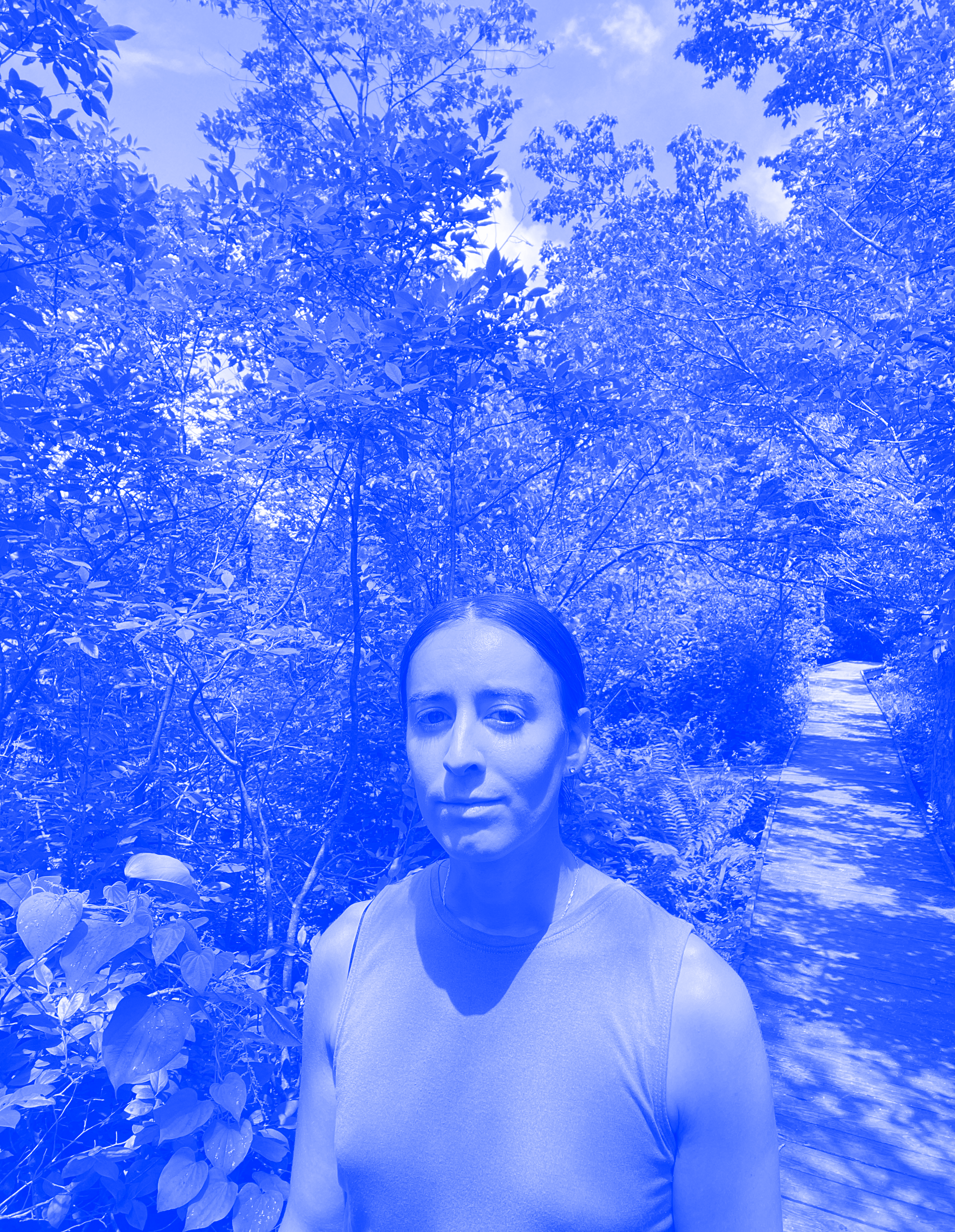
Rian Ciela Hammond is an artist whose work weaves queer ecology, feminist science and technology studies, social practice, and synthetic biology. Their transdisciplinary practice manifests installations, writings, and workshops, often aimed at unsettling binary constructions of gender, human/non-human, and synthetic/natural: persistent ideological technologies of coloniality. Recent works have turned towards wetlands as spaces of abundance, refuge, and queer belonging: storytelling with these multiplicitous beings at the indeterminable edges between land, water, and sky, between life and death. Their artworks have been exhibited at The Beall Center for Art + Technology in Los Angeles CA, Gray Area in San Francisco CA, The Albright Knox Museum in Buffalo NY, Bioart Society’s SOLU space in Helsinki Finland, and Hangar in Barcelona Spain. Their writings can be found in a volume on artificial intelligence titled Chimeras: Inventory of Synthetic Cognition (Onassis Foundation 2022), Culture Push’s online publication PUSH/PULL: Trans Family Archive, and Art as We Don’t Know It (Aalto University Press 2020). They have an MFA from State University of New York at Buffalo, and a BFA from the Maryland Institute College of Art. Hammond is based in the Weelaunee watershed (Muscogee and Cherokee land) aka Atlanta GA. CV

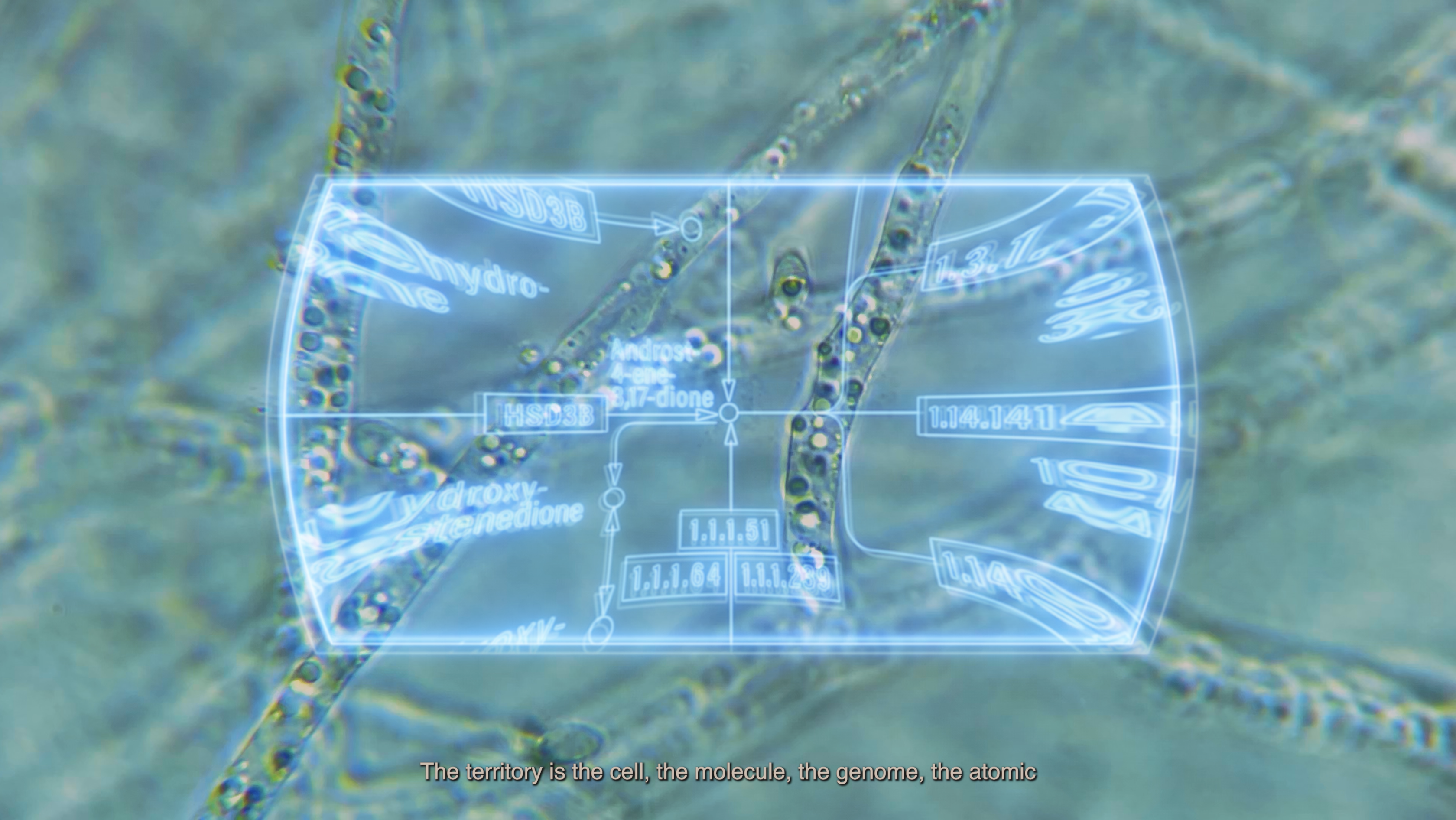


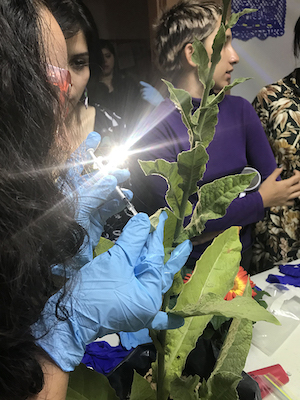


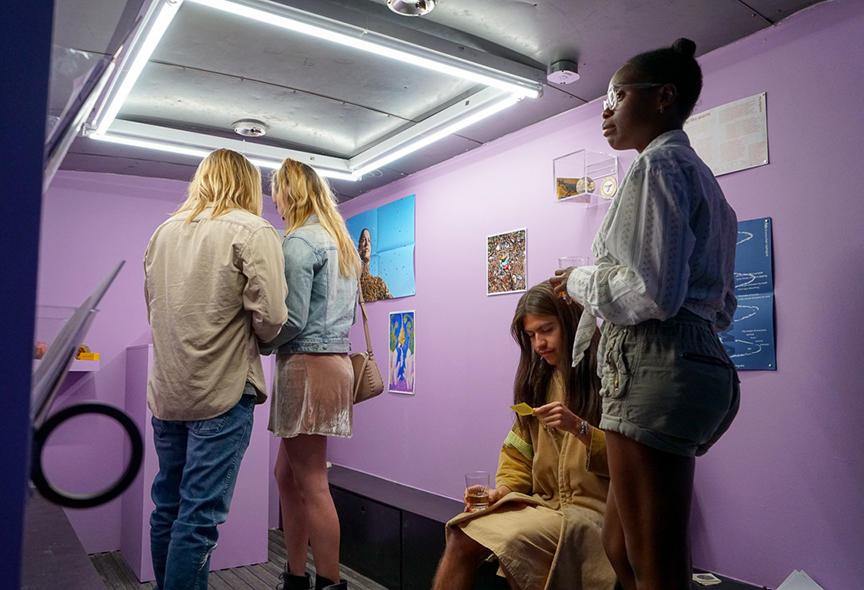



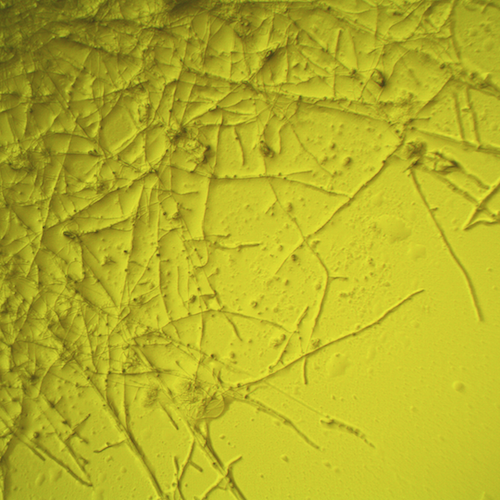
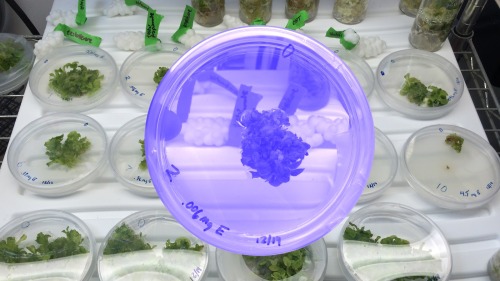





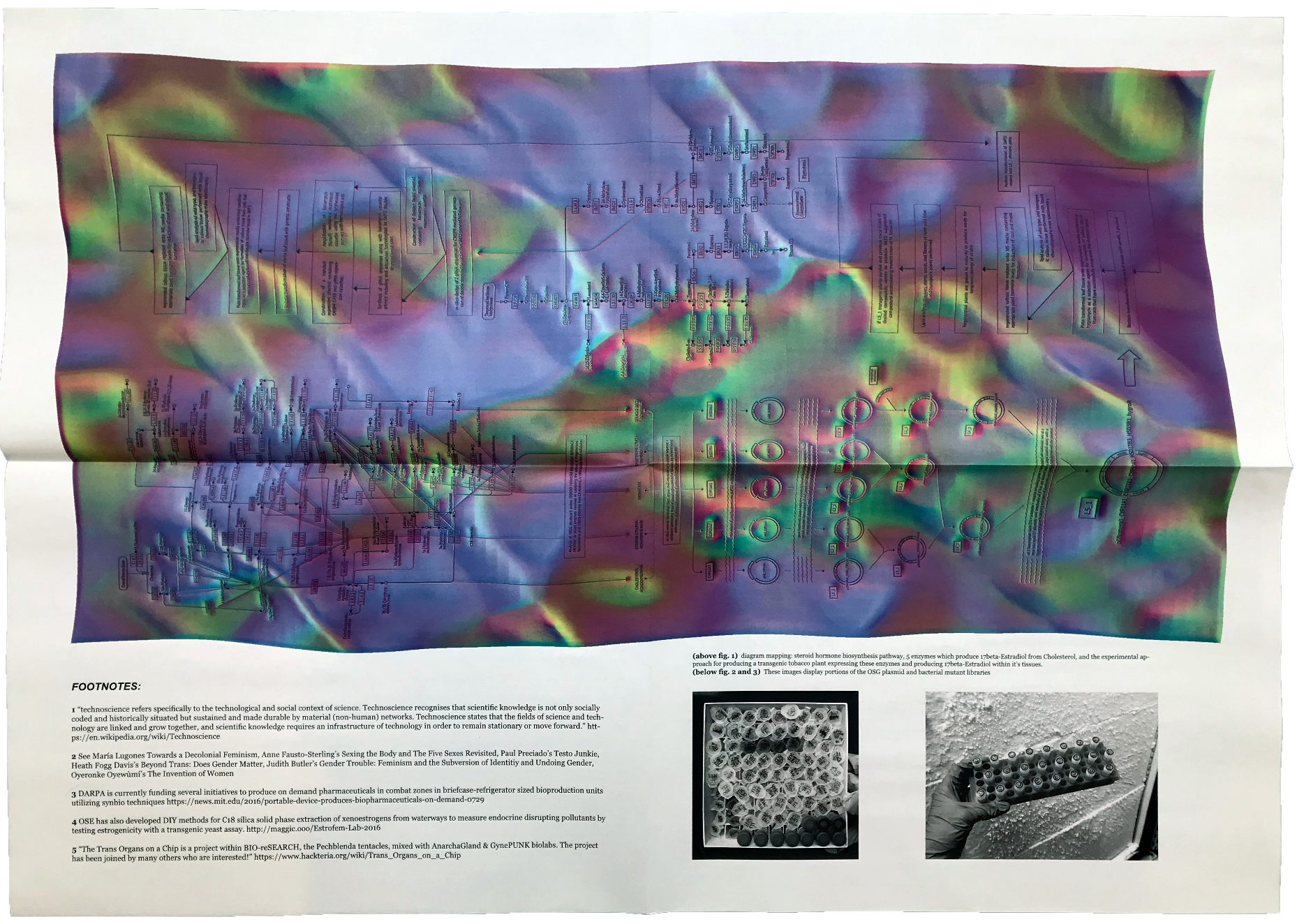
Becoming with Fungi
Gender Hacking in Der Raumstation
Drawing on the research and techniques Mary Maggic, Paula Pin and I developed while in residence at Prototyp_ome -- this workshop focused on the fungi Schizophyllum Commune and Pleurotus Ostreatus (Oyster) and their abilities to degrade endocrine disrupting petrochemicals (EDC's). In the first half of the workshop we discussed the socio-political side of hormones and EDC's and reviewed the science. We then set out to extract EDC's from plastics, urine, and personal care products brought in by workshop participants. We diluted cosmetics, shampoos, lotions, and fragrances and used cheap peristaltic pumps and silicone tubing to pump these solutions through C18 columns. These columns contain a filtration substrate designed to catch hormonally active molecules such as testosterone, estradiol, hydrocortisone, BPA, and Nonylphenol. We also extracted toxins from plastic bottles by cutting them up into small bits and boiling them in water. This fluid was passed through the C18 filters as well as the urine of workshop participants as it's been well documented that the urine of people all around the world contains the EDC's that are now ubiquitous in environments worldwide. Once the filters were saturated with the extracted chemicals, we used a small amount of methanol to "elute" the chemicals off the filter and into a glass cup. This process is called Solid Phase Extraction or SPE. The cup was heated to speed up evaporation of the methanol, leaving only the EDC's which we could then feed to our fungi friends. Working off of this paper, we hypothesized that the presence of endocrine disruptors could enhance lignocellulosic enzyme production by the fungi. By feeding this pollutant concoction to the fungi, the workshops act as crude "directed evolution" experiments ~ a practice of becoming with these fungi in a toxic world. For more details about the scientific background, check out the details of the Prototyp_ome Residency.















Prototyp_ome Residency
The Prototyp_ome residency is a collaboratory formed by HANGAR (an arts space in Barcelona with emphasis on use of open source tools), the Barcelona Biomedical Research Park (PRBB), and Pechblenda lab run by Paula Pin. While in residence my work was focused into two areas: the first was to use funds to design and synthesize genes involved in steroid hormone synthesis, and generate a library of DNA plasmids for "Open Source Gendercodes" experiments. The second focus was on developing new work in collaboration with Paula Pin and Mary Maggic to work with the organism Schizophyllum Commune, and it's various entanglements with endocrine disrupting petrochemicals and hormones. This new work, we are calling "Becoming with Schizophyllum Commune" had these three goals: 1 ~ Reasearch and digest the scientific literature on Schizophyllum Commune and it's various interactions with hormones and endocrine disrupting petrochemical pollutants. S.Commune is one of many "white and brown rot" fungi with the ability to break down hormonal and endocrine disrupting pollution. These fungi feed off of trees by excreting "lignocellulosic" enzymes from their networked bodies or "mycelia" and the enzymes are able to break down the cellulose and lignin that trees are made of. Because of structural similarities between cellulose, lignin, and EDS' / Hormones like Atrazine, BPA, Estradiol, Diethylstilbestrol, and Nonylphenols, the "lignocellulosic" enzymes secreted by the fungi can also break down a wide variety of toxicants. In addition to this, S.Commune produces immunostimulating polysaccharides that are helpful as cancer preventatives and treatments (Approved in Japan for treatment of cervical cancers), can enhance phytoestrogenic properties of certain plants through fermentation, can be used in place of rennet and lactobacilius in cheesemaking processes, and produce thrombin clot dissolving enzymes (useful in treating thrombosis). Strangely, these same "beta-glucans" that can be extracted with boiling water as cancer treatments and immunostimulants, are also used by the petroleum industry to enhance oil yields, tying S.Commune in a bizaar feedback loop to the production of the endocrine disrupting petrochemicals it is able to degrade and remediate. 2 ~ Develop DIY and DIWO (do it with others) protocols that simplify these recipies for working with EDC's and fungi to translate codified scientific knowledge into a language that is more accessible. Use these recipies for education, for questioning, for resistance to molecular colonizations, and creating new narratives about multispecies becomings and our collective mutagenesis. 3 ~ Challenge the dominant cisheteronormative, queerphobic discourse surrounding endocrine disrupting chemicals (EDC's). To quote Malin Ah-King and Eva Hayward's scholarship on the issues, "Many news outlets are reporting these frightening endocrine tales from our backyards. In an effort to foreground these issues—as we will describe in the following—media has gaslighted a Frankenstein metamorphosis that threatens sex and sexuality. Rather than addressing the many other health risks associated with toxic exposure, the most sensational and polemical issues stand in for debate and critical response. It raises questions: Why is sex more central than cancer, auto-immune disease, and even death? What cultural nerves (many of which are globalized), are triggered? And, for those of us with feminist concerns, how do we reorient the debate away from essentialism, sexism, and heteronormativity?" (Toxic Sexes). Schizophyllum Commune is a unique "white rot fungi" in that it has been found to have over 28,000 genetic sexes. This adaptation, many theorize, has enabled the incredible genetic diversity of this species which exists on every continent around the world except Antarctica. We wanted to celebrate the beautiful sexual multiplicity of this organism as one example of the queerness of biology. The dominant discourse surrounding EDC's in the media, and even from environmental activists focuses heavily on unscientific narratives, that these molecules cause certain sexualities or genders that our society pathologizes, labels non-normative, and often seeks to eliminate or avoid. Not only is the sex-panicked, queer phobic focus of public outcry about EDC's scientifically unrealistic (hormones and endocrine disruptors do not make people queer or trans) but it is ignoring all of the devastatingly real effects that we can link to EDC's: obesity, thyroid disorders, certain cancers, among other health risks.
OSG Research Documentation
Documentation from the process of: producing a library of genetic mutants for further experiments, and verifying proper integration of genes. The last two images are the first yeast transformants producing enzymes envolved in steroid hormone synthesis ~ created at the Barcelona Biomedical Research Park.
Becoming with Fungi Documentation